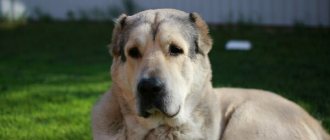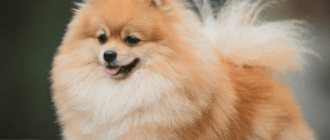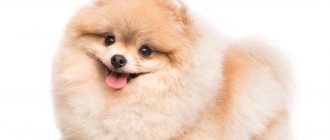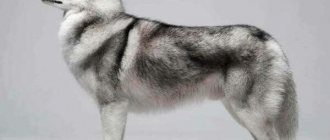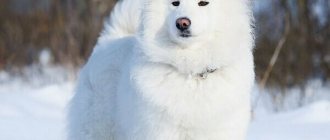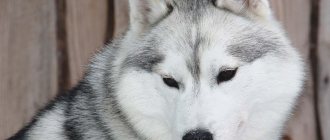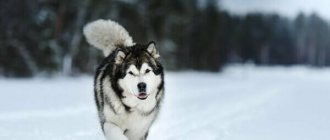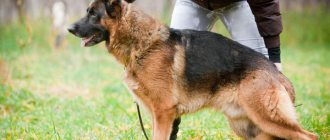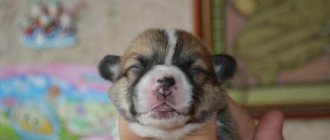Alabais belong to large breeds of dogs, the weight of which must be carefully monitored, because the health of the pet and its life expectancy depend on it.
Indeed, for animals whose body weight exceeds 50 kg, it is very important to avoid overfeeding and obesity, which can lead to serious health problems, in particular to diseases of the musculoskeletal system or the cardiovascular system.
This is why it is so important that an adult animal’s body weight matches its height.
Owners of Alabai puppies also need to constantly monitor the pet’s height and weight, but in order to know how correctly and harmoniously it is growing and developing.
Description
The Alabay (Central Asian Shepherd Dog) is a multi-purpose working dog native to Russia and the former Soviet republics of Central Asia. The breed is used for livestock protection, dog fighting, personal and property protection, and military work. The Central Asian Shepherd is one of the most popular breeds in the region of its origin. Alabai is a large and strong pet. It can not only survive, but also thrive in the harshest conditions found on Earth.
— Advertising —
The Alabai dog is shown in the photo.
Possible diseases and methods of treating them
The Central Asian Shepherd is one of the strongest breeds. She is muscular and resilient, beautiful and graceful. But even such a dog is prone to illness. The main problem of the Alabais is parasites. It’s hard not to “catch” them, especially if your pet spends a lot of time outside.
Even if there are no fleas on his body, still give him medicine for these pests. It should be prescribed by a veterinarian who previously examined the dog. He will also calculate the dosage of the drug.
To prevent an animal from becoming infected with a dangerous disease, such as plague, it must be vaccinated in the first months of its life. The veterinarian informs the breeder about the vaccination plan.
If you want your pet to never get sick and always feel great, don’t skimp on his food! In addition to high-quality dry food, give him vitamins, fruits, berries and vegetables.
Appearance
The head is massive and wide. The forehead is flat. The nose is large, black or brown. The pet's jaws are powerful. There are 42 white teeth in the mouth.
The ears are triangular in shape and medium in size. Sometimes they are pruned if this is not prohibited in the country.
— Advertising —
Eyes: wide-set, round, dark in color.
The pet's body is powerful. The neck is short and muscular. The chest is large, the ribs are rounded. The loin is short, wide, slightly convex. The abdomen is moderately tucked. The back is strong, straight, wide.
The tail is thick at the base and set high. In a calm state, the tail is ring-shaped. In some individuals it is docked, unless this is prohibited in the country.
The coat is hard, straight and rough. The length depends on the type. Long-haired: 7 to 8 cm in length, short-haired: 3 to 5 cm in length. Under the fur there is a thick undercoat.
Alabai colors include the following: white, black, black and white, gray, straw, reddish brown, red, brindle, motley, spotted.
Pictures of black and white alabai are presented below.
The size of the Alabai dog is impressive.
Height: male 65-78 centimeters, female 60-69 centimeters.
Weight: male 50-79 kilograms, female 40-65 kilograms.
What weight should an adult Alabai have depending on gender?
The dog's health and activity depend on proper nutrition.
To make sure that the dog is growing normally, it is important to know how much an adult Alabai weighs.
According to the breed standard, the minimum weight for females is 40 kg, and for males - 50. The maximum weight is not limited by the rules: it can reach 65 kg for females and 80 for males. It is important to ensure that heavy dogs are not obese. Most Alabais - winners of sports competitions - weigh up to 60 kg. Larger dogs often become clumsy and less maneuverable. If the dog begins to gain weight, it is necessary to reconsider its diet and gradually increase physical activity. Additional Information! Due to the fact that the export of purebred Alabais from Turkmenistan is currently prohibited, most animals from Russian breeders are mestizos. Therefore, the weight of a dog may depend on which breeds were present in the genetics of a particular individual.
Pros and cons of a dog
Characteristics of advantages:
- This is an extremely loyal pet.
- Alabai gets along well with people.
- The dog has excellent watchdog skills.
- Animals form deep bonds with their owners.
- The adult Alabai is an excellent defender.
- He is smart and confident.
- The dog gets along well with children if they are from his family.
- The animal is in good health.
- Caring for a pet is not difficult.
Characteristics of minuses:
- When you adopt a puppy, it is difficult to predict what kind of temperament it will have.
- He is distrustful and aggressive towards strangers.
- The Alabai dog has a strong-willed and independent character, so it is difficult to train him.
- Sheds heavily in spring and autumn.
- Often aggressive with other dogs.
- You need to constantly work with your dog.
- It requires a lot of space (both indoors and outdoors).
- The impressive size of the animal can be dangerous for small children.
- The dog is not hypoallergenic.
- The pet may bark at night.
How to measure height correctly?
In order to measure the height of a puppy or adult Alabai with the smallest possible errors, you need to place the pet on a flat, hard surface, after which you need to attract its attention with a treat, toy or words, and thus make it stand still during the measurement.
At the same time, to facilitate this task, it would be advisable to use the help of assistants from among relatives who will distract the pet’s attention while measurements are being taken.
Next, take a centimeter and apply its edge with the smallest values to the most prominent point on the animal’s withers. The lower edge of the measuring tape is lowered down perpendicular to the floor and a mark is made on it in the right place.
NOTE!
It is more convenient to measure a dog’s height not with a centimeter, but with the help of a special device, which is a ruler with divisions marked on it and a limiter in the form of a freely sliding bar along it.
In order to measure the growth of an Alabai using this device, the ruler is lowered with its lower edge to the floor, and the limiter is raised to the top point of the withers and fixed at the desired mark.
The length of the ruler from the floor to the stop is also the height at the withers.
History of the breed
The Alabai breed has an interesting history. These dogs were kept exclusively by nomadic herders who left few archaeological remains. Most of them were illiterate and therefore could not write about their dogs. The description of the Alabai dog indicates that the pet’s native region is Central Asia.
You need to understand how huge this region is. It includes: Turkmenistan, Uzbekistan, Tajikistan, Kazakhstan, Kyrgyzstan, areas surrounding the Caspian Sea and the Altai steppe. It is important to know the history of these places: the highlands of Tibet, Tien Shan, Pamir and the Great Steppe, through which tribes and peoples passed for centuries.
Numerous factors influenced the formation of the breed. Non-trivial conditions have formed many of its types. It is impossible to single out a specific subtype and claim that this is a real Alabai.
Due to the previously mentioned limitations, it is impossible to say with certainty when the Alabai breed developed. Even the earliest records of the region indicate the presence of these dogs. They have most likely existed for the past few thousand years.
There are two main groups of theories that try to explain the origin of the Central Asian Shepherd Dog. The first says that the Alabai descended from ancient Middle Eastern breeds that guarded livestock. The second says that the dog descended from the Tibetan mastiff.
The earliest dogs performed many roles in human society: they guarded homes, helped in hunting and herding livestock, were a source of meat and hides, and took part in battles.
Farmers of that time deliberately bred pets that had different, bright colors. This was necessary to distinguish our own from strangers, as well as from predators. To successfully fight wolves, dogs needed powerful jaws and fairly large heads. Farmers have also discovered that short, wide muzzles give their animals the largest possible bite area. The weather in those regions was harsh: cold winters, strong winds. Therefore, people tried to breed individuals with long hair.
The Central Asian Shepherd Dog also began to play an important social function in the region. Periodically, many tribes and clans gathered together. These meetings usually included religious and holiday festivals, political discussions, and so on. Tribesmen brought Alabais with them, especially males. The dogs confronted each other in dog fights. These fights were very different from the illegal fights that remain popular in the United States and the British Isles. Their point was not for dogs to fight to the death. In a confrontation they determined which animal was better.
Central Asia's harsh climate and landscape would likely make the region one of the most isolated places on Earth. However, it had a great location. Central Asia borders and lies between four of the world's most populous, wealthy and historically important regions: Europe, the Middle East, China and India. The famous Silk Road ran through Central Asia. To prevent theft, traders used Central Asian Shepherd Dogs to guard their caravans.
Dogs turned out to be so useful that they quickly spread throughout the world. Dogs were crossed with larger, longer, long-haired individuals, which led to the emergence of Spitz-type animals.
Existing data about the Alabai dog indicate that there are currently four main lines of the breed. Each has significant differences in temperament.
- Animals that are bred for conformation displays. They are the most controllable and least aggressive.
- Animals bred to protect livestock. They are usually subject to the highest demands on physical strength. These dogs demonstrate the most stable and predictable character. Although they tend to be more aggressive than show line dogs.
- Animals bred for dog fighting. They have the most unpredictable character and the highest level of aggression.
- Animals bred for military purposes. They are very aggressive towards people and work-oriented. However, this line is more predictable than the fighting line.
Description of an adult and a small shepherd
Male
Externally, males always look more massive and courageous. Their withers are more muscular and more clearly defined.
In addition, males are distinguished by their calm behavior. They like to be on a hill from where they can look around the surrounding area.
Bitch
Females are most often smaller and lighter than males . They have a longer body and a smaller head. Bitches prefer to control the situation, constantly inspecting the entire perimeter of their territory.
Puppy
The puppy grows up quite quickly, and by the age of 9 months it has the characteristics of an adult dog. Growth continues after the 9th month of life, and ends only by two to three years. All this time, the puppy continues to build muscle mass.
Kinds
Depending on the place of cultivation, several varieties of the breed have appeared. Below is a description of the different types of Alabais.
Caucasian
This is the rarest variety of Alabai dog breeds. It will be difficult to get puppies. The Caucasian Alabai is lighter and more resilient than, for example, the Turkmen species. But at the same time, individuals are much more aggressive than their Turkmen counterparts.
Main characteristics:
- The dog's weight is up to 75 kilograms, height is up to 70 centimeters.
- The Caucasian Alabai loves freedom very much.
- Dogs will not tolerate command over them except from their master.
- Pets have a lot of energy, so they need ample space for physical activity.
- The Caucasian dog Alabai is very smart. She can predict the enemy’s tactics, and then she will be the first to fearlessly attack him.
What Caucasian Alabais look like is shown in the video.
Turkmen
It is believed that this is the most ancient species that laid the foundation for the breed. His parent and predecessor is the Tibetan Mastiff. The Turkmen alabai is the largest of all varieties.
Main characteristics:
- The weight of the animal is up to 80 kilograms, height is up to 65 centimeters.
- The dog is used as a guard, not for fighting.
- The Turkmen Alabai dog gets along well with other animals, as long as it remains a leader.
- Personality Traits: Fierce, loyal, confident, balanced.
- It is best to avoid keeping these dogs with small children and the elderly.
- Turkmenistan has declared that the Turkmen Alabai breed is a national treasure. By law, pets cannot be taken out of the country.
Central Asian
The Central Asian or Asian Alabay is the most common species throughout the world. The breed was formed over a vast territory over more than four thousand years. It extends from the Caspian Sea to China, as well as from the Southern Urals to Afghanistan.
Main characteristics:
- The weight of the animal is up to 80 kilograms, height is up to 80 centimeters.
- The Central Asian Alabai is self-confident, balanced, calm, proud and independent.
- Asian Alabai are brave, hardy, have high performance and a natural instinct for protecting the territory.
- This breed is known for its fearlessness towards large predators.
- Although they are extremely affectionate and protective of their owners, these pets are not for beginners.
German
It is believed that the German Alabai descended from the “bronze dog”. She is a mixture of a wolf and an ordinary German dog. A characteristic feature of these individuals is a high degree of obedience.
Main characteristics:
- The weight of the animal is up to 80 kilograms, height is up to 65 centimeters.
- The breed was widely used in the army during World War II. Due to this, many animals died. But, starting in 1945, the variety began to be revived in Germany, the USA, Japan and the USSR.
- This is not a very aggressive species.
- Thanks to his internal instincts, the German Alabai perfectly senses danger.
- This is a hardworking animal. It is necessary to devote a lot of time to physical activity.
Siberian
For the first time, the Siberian Alabai was bred in the cold climate of Siberia. Due to the harsh conditions, the dog historically developed long hair and thick fur. It is believed that the Siberian Alabai is a cross between a German Shepherd and a Siberian Husky.
Main characteristics:
- The weight of the animal is up to 90 kilograms, height is up to 75 centimeters.
- The dog absorbed all the best qualities of his parents.
- The pet will listen to you unquestioningly and is easy to train.
- A good watchdog.
- The animal is smart, loyal, gets along well with people.
Types of Alabai dog breeds are presented in the photo.
How much does a Central Asian Shepherd cost?
The Alabai puppy is evaluated depending on its suitability for the breed. There are three classes of “suitability” of dogs:
- Pet. The individual will not produce purebred offspring, but will be a good guard. The average price is 15,000 rubles.
- Breed. Typical purebred CAO. Estimated at 15,000 – 20,000 rubles.
- Show. Unique purebred Alabai. For such a puppy, breeders will ask for at least 30,000 rubles.
When purchasing a dog, do not forget to check that the documentation is correct.
Maintenance and care
Keeping and caring for animals will not cause you many difficulties.
The room where the dog lives must be kept clean. The floor should be mopped daily. Vacuum and wash the sleeping area every week. Do not allow your animal to sleep on upholstered furniture or mattresses.
The place where the pet sleeps should be away from windows and radiators. This is necessary to avoid drafts, hypothermia, and overheating. It is best to choose a quiet corner, away from doors and passages.
It is not recommended to keep the Central Asian Shepherd in an apartment. However, this recommendation cannot be considered a direct ban.
The animal must move a lot. In an apartment with a lot of furniture and fragile things, it will be too playful. Therefore, walk your pet 2 times a day.
No less important in caring for the breed is taking care of the coat. It is necessary to clean it daily with a special mitten or a brush with coarse bristles.
In addition, check and clean your pet's mouth, ears and eyes every day with a special cotton swab. Human ear sticks are not used to care for your dog's ears. They can easily cause injury, ultimately leading to deafness.
There is no need to wash the animal often. The procedure is carried out as needed, preferably no more than once a month. Use high quality grooming products. After bathing, the coat should be well dried to avoid hypothermia. This is especially important in the cold season. You can also use a hair dryer to dry it.
Nutrition
What are the breed's feeding requirements? Alabais are large animals that consume a lot of energy and need to be replenished. Therefore, feeding pets has its own characteristics.
Feed an adult pet 2 times a day. If your pet is highly active, add another meal during the day. Try to give food that is not too cold, but not too hot. Feed your dog about two hours before walking. After the meal, your pet should rest a little.
For the proper development of the body, the dog must receive proteins that cannot be replaced. The daily requirement for protein is about one hundred grams. High protein foods are meat, fish, and milk.
An adult dog should consume about 25 grams of fat per day. Without them, metabolism will be incorrect. The dog's body is not able to properly process vegetable fats, so give him fats of animal origin.
Alabai needs 350 grams of carbohydrates per day. They are a direct source of energy. Potatoes and various cereals are rich in carbohydrates.
The pet also needs elements such as calcium, magnesium, and potassium. Usually, they are contained in sufficient quantities in food. With a lack of micro- and macro-elements, serious diseases can occur. For example, brittle bones, nervous system disorders. To prevent such conditions, periodically give your dog meat and bone meal. Add 100-200 g to porridge or soup 2-3 times a week.
To ensure balanced nutrition and convenience, it is recommended to create a menu for the week. The main product for alabai is meat with a high calorie content. Make sure it is fresh, without signs of spoilage.
For feeding, lean meat is used - beef, lamb, horse meat. Alternatively, you can use jerky. At least once a week, animals should be given raw meat in small pieces.
You can sometimes feed your dog corned beef as a treat. Corned beef is a meat product that is obtained by aging raw meat in salt. However, it needs to be washed well and boiled before feeding your pet.
The daily intake of vegetables is 250-350 grams. Suitable for alabai are: cabbage, carrots, lettuce, beets, potatoes, spinach, young nettles.
To enrich the body with fats, periodically give your dogs fish oil.
You can also treat your dog to 300 grams of bread per day.
The animal should always have access to clean water.
Most Alabai owners are inclined to believe that dogs need to be fed natural food. But it is also possible to feed and switch to dry food. Such a decision must be thoughtful and balanced. Frequently changing natural food to dry food leads to problems with the stomach and intestines. In this case, you should consult a veterinarian.
Why doesn't he eat?
There are several reasons why your pet may refuse food:
- Change of food. Perhaps the dog doesn't like the new food and doesn't want to eat it. In the case of natural food, there may be an ingredient that is disgusting to the dog.
- Extra treats. Perhaps your animal is simply not hungry, as it constantly receives additional food between meals.
- Unusual food. Excessive amounts of salt or spices may cause you to refuse your usual food.
- Pain. It may be painful for your pet to eat. This can be caused by dental infections or toothache.
- Infections. For example, with ear infections, your dog may lose his appetite.
- Serious illnesses. Typically, they are accompanied by the following symptoms:
- Shiver.
- Hard breath.
- Decreased activity.
- The animal humps its back.
- The dog sleeps a lot.
You need to urgently contact a veterinarian to determine the cause.
Labrador puppy sizes by month
The main characteristics in the development process of a dog are its height and weight. Each breed has its own norms, a significant deviation from which indicates improper development, nutrition and other deviations.
Development by day in the first month
A newborn Labrador puppy weighs about 400-550 g. Daily weight gain is about 100 g. Accordingly, weight indicators in the first month will be as follows:
- 1 day – 400-550 g;
- Day 7 – 1200-1350 g;
- Day 14 – 2000-2300 g;
- 21 days – 2700-2950 g;
- Day 30 – 3400-3800 g.
Thus, every week of life the puppy gains about 1 kg in weight.
Interesting! According to experienced breeders of these dogs, it doesn’t really matter what weight the puppies are born with, what’s important is follow-up care and genetics.
Height at the withers by the first month is about 23-13.5 cm.
Optimal weight gain and growth of a puppy is an indicator of its health and proper development
Development of puppies from 1 month to a year
In order to control the weight of a Labrador puppy by month, you need to focus on the norms for the development of the animal.
The table below will present in detail what the weight of a Labrador puppy should be by month:
| Puppy age (months) | Puppy weight (kg) | Height at withers (cm) |
| 2 | 7–8 | 30–32,5 |
| 3 | 12–14 | 39,5–42 |
| 4 | 17–19 | 44–46 |
| 5 | 21–22 | 48–51 |
| 6 | 24–26 | 50–55 |
| 7 | 26–28 | 52–56 |
| 8 | 28–30 | 54–57 |
| 9 | 29–32 | 54–58 |
| 10 | 30–34 | 54–58 |
| 11 | 31-35 | 55-58 |
| 12 | 32-36 | 56-58 |
Based on the table, we can conclude at what age a Labrador retriever actively grows.
Indicators by month:
- 1 month. The baby is born weighing only 400 g. In the first 30 days, a daily increase of 100-120 g is observed. Upon reaching the age of one month, boys weigh about 3.7 kg, girls - 3.4 kg.
- 2 month. The puppy is growing rapidly and gaining weight. By the 60th day of his life, his body weight reaches an average of 7-8 kg.
- 3 month. Gaining 100-120 g every day, by the end of the month the cable will weigh 13-14 kg, the bitch will weigh 12-13 kg.
- 4 month. A four-month-old puppy gains weight in the range of 17-20 kg. At the withers, the Labrador reaches 46 cm.
- 5 month. At this age, the puppy is actively gaining weight and increasing in size. By the end of the 5th month, the animal’s weight approaches 21-23 kg. Height at withers – from 48 to 51 cm.
- 6 months. By six months, the puppy becomes more like an adult dog. At the withers, the Labrador reaches 50-55 cm, with a body weight of 24-26 kg.
- 7 months. At this age, dogs reach sexual maturity, but mating should be strictly avoided. Early pregnancy in bitches will negatively affect not only their offspring, but also the health of the expectant mother. Puppies weigh 27-28 kg at this time.
- 8 months. By this age, weight gain occurs very slowly. Labradors during this period weigh from 28 to 30 kg. Their height is between 54-57 cm.
- 9 months. The dog's skeleton practically does not grow; there is an expansion of the chest and an increase in muscle mass. The optimal weight is considered to be 29-32 kg.
- 10 months and beyond. All parameters, starting from this age, correspond to an adult. Height at the withers is about 58 cm, weight 30-40 kg.
To monitor its growth, it is necessary to regularly measure the puppy at the withers. For this procedure you will need a centimeter and a good mood of the animal. Since active growth occurs during this period, measurements are recommended to be taken every month.
Advice! The best time to measure your Labrador Retriever is when he is not hungry and calm. This way you can get the most accurate values.
It is especially important to comply with the standards for dogs that are to be shown and participate in breeding. To ensure that the weight and height of a Labrador puppy corresponds to the norm and does not deviate from it, it is important to provide the baby with a complete balanced diet, proper care and sufficient physical activity.
Six-month-old Labrador puppy
Excess weight is undesirable and dangerous to health, as is its lack. Therefore, in the first year of a puppy’s life, it is necessary to closely monitor its development.
Girl
The girl's height is 60-69 centimeters, her weight is 40-65 kilograms
Sexual dimorphism in this breed is clearly visible. Alabai girls are usually smaller in size and not as strong.
There are also differences in temperament. Bitches are more resourceful and cunning. They also absorb material worse during training, unlike the opposite sex.
Dimensions, weight and other distinctive features
Pet size and weight:
Male:
- Height – from 70 – 80 cm.
- Weight – from 70 to 80 kg.
Bitch:
- Height – from 65 to 72 cm.
- Weight – from 50 to 70 kg.
A distinctive feature of black Alabais lies in their specific genes . So from one litter from black parents completely different puppies can appear.
Moreover, they will differ in color (not all of them are black), in character, temperament, and attitude towards people.
Nicknames for Alabai
The nickname Alabai is given once and for life. Before you name your pet, look at it carefully. Perhaps some character traits or color will help you choose the right name.
For boy
Popular boy nicknames with meaning:
- Aydin is the moon.
- Ayik is a bear.
- Aikol – noble.
- Darman is strength.
- Ailaker is dexterous.
- Jasur – brave.
- Kagysh - fight.
- Miyat is a protector.
- Palvon is a hero.
- Zangar is a giant;
- Kashan is beautiful.
- Sardar is a leader.
- Tupan is a hurricane.
- Nuker is a fighter.
- Enish - victory.
- Khaibat is a threat.
- Demir - iron.
- Kamal is a fortress.
- Yur is neat.
- Zangar is a giant.
- Kubat – strength.
- Derkan is correct.
- Kamtar is modest.
For girl
Popular nicknames for girls with meaning:
- Ai – moon, month.
- Aina – glass.
- Alada – care.
- Altyn-Gul is a golden flower.
- Orzu is a dream.
- Vepa – loyalty.
- Gala is a fortress.
- Nabira is a granddaughter.
- Kadama - armor.
- Paida - good.
- Kecha - night.
- Tara is the world.
- Tylla is gold.
- Kelin is the bride.
- Nezi – gentle.
- Shagga - quickly.
- Egna – needle.
- Vada is a promise.
Breeding
The female's pregnancy lasts 56-64 days. A week before the expected date, choose a place for birth. A pregnant Alabai bitch should get to know him.
It is advisable to prepare disposable diapers, cloths, medicines, a baby box, warm water and scales.
Signs of labor are as follows:
- The girl is losing hair in the nipple area.
- The pet became restless.
- Immediately before giving birth, the girl begins to experience intermittent breathing. One gets the feeling that the dog does not have enough air after running.
- A day before giving birth, a plug comes out (this is a blood clot that blocked the cervix).
Since Alabai are strong dogs, they usually give birth on their own. But still, you must control the situation and stock up on the veterinarian’s number in advance.
The bitch gives birth to 9 to 12 puppies. Their weight is 500-700 grams. Monitor your dog after birth. She can “torture” kids with her love.
How old do they grow?
Loose stools in a dog or puppy: causes and what to do
Intensive growth of Alabai dogs is observed in the first 6 months of life. After this, the pace decreases noticeably.
Most Alabais gain maximum weight and height before one year. But this does not mean at all that the dog does not grow later, it just happens slightly. Alabai grow up to three years of age. But this applies, first of all, to males, since females stop growing with the onset of their first heat.
Puppies
Before purchasing Alabai puppies, weigh the pros and cons. But if you decide to make such a friend, there are several rules when purchasing.
- Don't buy from poultry markets. If you want a mentally and physically healthy dog, choose your breeder carefully.
- Before purchasing, carefully study photographs of puppies of this breed. You should know well what an Alabai puppy looks like: height and size, coat color, habits, and so on.
- Pay attention to your parents, they must be in good health.
- Take a puppy that is 2 months old.
- Choose a curious, not shy baby.
- The Alabai puppy should be energetic, healthy, with straight legs, clean coat, eyes, ears and a wet nose.
The average price for a small Alabai from a regular breeder is about $500-700.
If you want to buy a premium puppy, you will have to pay around $1,500.
What does a puppy look like before 12 months of age? The average data is shown below.
| Age, months | Weight, kg | Height, cm |
| 1 | 3-5 | 25-30 |
| 2 | 9-10 | 35-40 |
| 3 | 12-18 | 40-45 |
| 4 | 20-30 | 50-55 |
| 5 | 32-37 | 55-58 |
| 6-8 | 36-50 | 60-65 |
| 9-10 | 60-70 | 75-80 |
| 11-12 | up to 80 | up to 80 |
What to feed an Alabai puppy? Regardless of type and weight, your puppy's food should be well-balanced and rich in protein, vitamins, minerals and other essential ingredients.
Here are the essential nutrients your new friend needs daily:
- Proteins for the development of tissues, organs, muscles. They help prevent diseases. Proteins should be of high quality and make up more than 25% of the diet.
- Glucides also make a significant contribution to the healthy growth of your pet. They are mainly found in cereals.
- Essential fatty acids are important for the development of the nervous and immune systems. They are easily digestible and provide the body with vitamins and energy. They are found in meat.
- Calcium is necessary for proper bone development. It is found in milk and cottage cheese.
Feed puppies at the same time and in strict portions. Give your pet as much as he can eat at one time. Food should not be in the bowl all the time. The diet consists of meat products, cereals, fresh vegetables and herbs. Dry food is not recommended for a puppy. Eating too much liquid food can lead to intestinal twisting.
Babies should not be overfed, even if they ask for more. This not only threatens excess weight and stress on the bones, but also leads to stretching of the stomach.
How many times a day should you feed the baby?
| Age | Number of meals |
| From 1 to 3 months | 5 times a day |
| 4 to 5 months | 4 times a day |
| From 5 to 8 months | 3 times a day |
| From 8 months | 2 or 3 times a day, depending on activity |
New products are introduced gradually and in small portions. If an allergic reaction is detected, the product is excluded. It is recommended to give your puppy a raw chicken egg 2 times a week. It is useful to give the shells, previously crushed in a coffee grinder.
Several times a week, meat products are replaced with boneless fish. Give your animal pig ears, cheeks, hooves, and beef bones as a treat 2 times a week.
How to help your puppy gain weight
For an Alabai dog, weight and height can fluctuate within 10% of normal. If there is severe underweight and especially when the dog looks emaciated, it is important to take immediate action:
- visit a veterinarian to rule out the possibility of infection with worms or a more serious illness;
- feed your pet more nutritious ready-made formulas or increase the caloric value of the food that the owners prepare for it;
- add (in moderation) physical activity to gain muscle mass.
Important! A growing puppy should not be overloaded with force, put on a harness with weights, or give nutritional supplements for muscle growth - this can seriously harm the baby’s health.
If a young alabai is kept in a booth, its size must be sufficient for the growing animal to stretch to its full height
In order to raise a large, beautiful and healthy dog that will delight its owners for many years, it is important from the very beginning to provide the puppy with the right conditions of keeping and feeding, and sufficient physical activity. Only in this case a good result will not keep you waiting.
Dog character
Central Asian Shepherds are famous for their loyalty and courage. They are highly valued in their native lands for their protective abilities. Dogs are loyal to their families and will protect them without hesitation under any threat.
Such animals are not the best choice for first-time owners. This is because dogs are difficult to train due to their size and temperament.
Alabai must be taught his place in the family. It is important for the dog to know who is the “alpha male” in the family. Otherwise, they may start to show their dominant side. This causes the pets to become unmanageable and therefore more difficult to handle. Early socialization of the animal is important. Their training should begin at a young age. Once the puppy arrives at its new home, you should set some ground rules.
With that said, specimens are a good choice for people who are familiar with their needs. Also, dogs are suitable for families with children.
Pets create strong bonds with babies. Subsequently, when the children grow up, the connection will not decrease. They will always protect their friend.
Animals don't like to be left alone. A long separation from all family members can lead to destructive activities in the home.
Dogs are also known to be a bit aloof and wary of strangers. It should be noted that the Central Asian Shepherd rarely exhibits any aggressive behavior towards those it does not know. She prefers to just keep her distance. But the animal will not allow a stranger into its territory while the owner is not nearby.
Dogs are very smart. They are able to make the right decisions and take action. It is for these qualities that they are valued in their native regions.
There is also evidence that individuals are used as therapy dogs.
If an Alabai is introduced to other dogs at an early age, they will get along well throughout their lives. Shepherds are also tolerant of other animals with whom they grew up in the household.
Dogs will happily chase the neighbor's cat on their territory.
Alabaev mating
It is recommended to untie a bitch of this breed on the third heat, but mating is best done on days 9–14.
In the very first days after the bitch has “flowed”, you should call the owner of the selected male and agree with him on the time of mating. It is necessary to discuss in advance all the conditions and how payment will be made. Usually, mating is either immediately paid for on the spot, or the owner of the male takes one or two puppies as payment for mating.
In this case, you should remember:
- Only healthy dogs with a balanced temperament and a stable psyche can be bred.
- Before mating, it is necessary to show the bitch to a veterinarian.
- 3-4 weeks before estrus, it is necessary to give the bitch anthelmintic, since later, during pregnancy and nursing, this cannot be done.
- For the first mating, you should select an experienced male.
- It is advisable to invite an instructor who will tell you what to do if any difficulties arise.
- As a rule, dogs are bred in the male territory: there he will behave more confidently.
- It is better to knit dogs in the morning, without feeding them, but giving them a good walk.
- It is advisable to have only three people present: the owner of the bitch, the owner of the dog and the instructor; strangers will only interfere.
- Mating should be carried out in a calm environment.
There are two ways of knitting: freestyle and manual.
In free mode, the dogs are left together for a while; in manual mode, the dogs are helped. The second method should be used only if the animals for some reason cannot breed on their own. Both dogs should have collars, and if the “bride” is too obstinate, then she should be muzzled.
The owner of the bitch needs to hold her by the collar with one hand and under the belly with the other. A male dog usually does not need help, but sometimes, if he cannot reach the bitch’s loop, he has to be seated.
During mating, you should not shout at the dogs and, of course, under no circumstances should you force them apart. Owners should reassure their pets if they show indecisiveness, and, conversely, calm them down if they become overexcited.
One or two days after the main one, it is recommended to carry out a control mating, especially if there is no confidence that the first one was successful.
Training
Training a Central Asian Shepherd can be downright unpleasant. This pet's high IQ is accompanied by stubbornness that is difficult to break. The key to the solution is your establishment of a leadership role and early socialization of the animal.
This is a smart, brave, independent dog that is used to dominating. Therefore, owners must be stronger and more consistent in training. If you do not have training experience, you should not take such a large and stubborn pet. When you clearly decide with the Alabai that you are a leader, training and socialization will go better. Be firm, patient and don't be harsh. On the contrary, praise and reward your shepherd when he obeys.
The ability to think for themselves was important when dogs had to survive in the cold mountains of Central Asia. Therefore, dogs are undoubtedly smart and resourceful. A talented trainer will be able to use this trait to their advantage rather than allowing the animal to manipulate the situation and get its way.
Early socialization and training are important for this breed. This is due to the fact that aggression and physical strength are easier to overcome at a young age. Start training your puppy as soon as you take the puppy into your home.
Exposing your baby to different situations, people, places, sounds and animals is important.
What is the purpose and character of alabai?
Nowadays, Central Asian Shepherd Dogs are successfully used as irreplaceable assistants to shepherds, they perform vigilant service, guarding houses, but they can also simply be faithful companions.
The character of the Alabai has been developed over several millennia, and at the genetic level they have established an aggressive attitude towards other representatives of the dog tribe. Despite this trait, Alabai are quite peaceful with dogs that live nearby, in the same house with them. Although Alabai are considered excellent defenders, they will never attack a stranger. They can only scare away the “enemy” with an angry growl.
Central Asian Shepherds are not considered fighting dogs, but in Turkmenistan dog fights are held every year, where representatives of this breed must show their qualities - courage, bravery and the ability to stand up for themselves. Calm self-confidence and the absence of excessive aggression are the main character traits of this dog.
Alabais are very proud, so it takes a lot of effort for them to begin to respect their owner. Only when the dog feels that there is a true leader in front of him will he begin to obey him. That is why every Alabai owner is strongly recommended to take a special obedience course, during which the dog will begin to recognize the owner as a dominant creature.
Alabais are extremely wary of strangers, and they can easily attack a strange dog, so you must walk with them on a leash. They relate well to children, love to play with them and can become their faithful protectors on walks.
Diseases
It is almost impossible to make any generalizations about the health of this species. Breeders claim that these are some of the healthiest individuals of all large breeds. The health of the Central Asian Shepherd is connected with its history. Dogs lived in some of the harshest conditions on Earth. At the same time, they fought against dangerous predators. Only the strongest could survive, and any genetic defects would be quickly eliminated.
However, those pets that have recently been crossed with other species may be susceptible to genetic diseases of those breeds.
The animal is known to have skeletal and visual problems. Therefore, owners are strongly advised to have new family members checked by veterinarians immediately. They will conduct genetic and other tests to identify potential health defects. This is especially valuable for conditions that appear in old age.
Large Alabai dogs are prone to the following problems:
- Hip dysplasia.
- Elbow dysplasia.
- Skeletal growth disorders.
- Heart failure.
- Heart problems.
- Problems with the spine.
- Arthritis.
- Bloating/Gastric Torsion.
- Progressive retinal atrophy.
- Cataract.
- Glaucoma.
- Heat intolerance.
- Deafness.
- Infections and parasites.
- Obesity.
- Dental problems.
Here is a detailed description of several serious diseases.
Hip dysplasia.
Hip dysplasia is one of the most common serious inherited diseases in domestic dogs. It is caused by a malformation of the above-mentioned joint.
Where the upper leg bone meets the femur, an “acetabulum” is created, shaped like a rounded, concave socket. In a healthy dog, the head of the femur, or kaput, fits almost perfectly into the acetabulum. Both are covered with a protective layer of cartilage. This cartilage prevents the two bones from rubbing directly against each other. The cause of the disease is a problem with the shape of the femur, the shape of the acetabulum, the cartilage between them, or perhaps some combination of these. Symptoms: lameness in the legs, the animal has difficulty standing up. Seek help from a specialist.
Bloating/Gastric Torsion.
Gastric torsion, more commonly known as bloat, is one of the most serious health problems in pet dogs. Without timely medical care, it usually leads to death. The death of a dog can happen in just one day!
In this condition, food and gas cannot leave the stomach. This promotes their accumulation, which increases bloating. As more and more food and bubbles become trapped, the stomach swells and expands.
The main symptoms: a sharp increase in the dog’s tummy, malaise, heavy breathing, vomiting with foam, pallor of the mucous membranes. Contact your veterinarian immediately.
Progressive retinal atrophy.
Progressive retinal atrophy is one of the most common genetically inherited conditions found in domestic dogs. This is the main cause of blindness in your pets.
The retina is located at the very back of the eye. It is responsible for collecting visual images and transmitting them to the brain through the optic nerve. The retina is divided into the inner or neural retina and the outer retina or retinal pigmented epithelium. The inner retina is further divided into nine layers, the outermost of which contains photoreceptor cells. They are usually called sticks.
The rods function in low light and detect shapes and movement. In animals with progressive retinal atrophy, rod cells are gradually destroyed. This happens until the dog becomes completely blind. The disease almost always affects both eyes equally, leaving the dog completely blind at one point. Symptoms: Your pet has decreased vision in low light or at dusk. For treatment, contact your veterinarian.
Glaucoma.
Glaucoma is an imbalance of fluid pressure in the eye. There is a fluid inside the eye called aqueous humor. Its composition is completely different from tears. Water humor is responsible for maintaining the correct shape and pressure inside the eye. It is constantly produced by the body, a process sometimes called "the tap." To maintain proper pressure, fluid must be drained regularly from the eye into the bloodstream. Water humor flows out of the eye through a mesh-like structure known as the drainage angle or "drain".
Glaucoma occurs when there is some problem with the drainage angle that prevents the proper release of aqueous humor. Water humor begins to fill the eye, causing it to expand like a balloon. As a result, intraocular pressure increases sharply.
Glaucoma varies greatly in severity and rate of occurrence. In some dogs, glaucoma worsens over weeks or months. For others, the condition results in permanent blindness over a period of days or even hours. Symptoms: watery eyes, constantly dilated pupil, swollen cornea, you notice that the animal sees worse. Contact your veterinarian for help.
Life expectancy and major diseases
The life expectancy of black alabai is from 12 to 15 years.
Main diseases :
- Obesity. About 30% of pets kept in apartments suffer from this disease. An unhealthy diet and a sedentary lifestyle also contribute to the appearance of excess weight. Another cause of obesity is heart attack.
- Diseases of the cardiovascular system (myocardial infarction, arrhythmia, etc.).
- Joint diseases (hip and elbow dysplasia, arthritis, rickets, myositis, arthrosis). The reason is the large weight of the animal, which puts increased stress on the paws.
- Skin diseases (demodex, ringworm, fungus, fleas and ticks).
- Cryptorchidism (non-descent of the testicle into the scrotum in males). The disease is considered genetic.
- Diabetes.
- Infertility in bitches is also caused by genetic abnormalities.
- Deafness.
- Intestinal obstruction.
- Enterocolitis.
Why are ears cropped?
Cropping of an animal's ears is done for the following reasons:
- Aesthetic purpose.
- Therapeutic purpose.
In ancient times, the ears and tails of pets were constantly trimmed. This was due to their purpose. The fact is that they could interfere in fights with predators and other dogs.
Nowadays, each breeder and owner chooses what to do. Some people think that Alabai does not look like himself with big ears and a tail. Others are of the opinion that docking is an outdated method that only causes pain to the animal.
Dream Interpretation
Many people are interested in: why do you dream about Alabai? In general, the dog has always been considered a symbol of friendship and loyalty. A dream with alabai portends news from your friend.
The color of the pet also matters:
- Black: Beware of your friend. Perhaps he is planning something against you.
- White color: Be confident in your close friend.
- Red color: means your boyfriend, husband or wife.
Remember the behavior of Alabai in a dream. The dog grins at you - beware of your friend. You are running away from an animal - beware of the pitfalls in life. You play with your pet - good news awaits you. A dog that barks, growls, attacks - scandals and insults will soon await you.
Red alabai
The red color of Central Asian Shepherds has many variations and shades. There are individuals with yellow-golden, light beige, reddish-red or copper-brown fur. The red color may be solid or mixed with white markings on the chest, belly, paws and face.
Alabai light red color
Representatives of this breed are especially beautiful, having the so-called wolf color. The main color of the animals' fur is bright red or with a gray-brownish tint, the belly, neck and chest are white, and the lower part of the forehead, cheeks and the area around the eyes are painted black or dark gray.
Alabai dark red color
Interesting Facts
- Alabais are the eighth largest dogs in the world.
- The record holder for size is an animal named Bulldozer. The largest Alabai in the world lives in Russia. The weight of the largest dog reaches 125 kilograms.
- The word alabai means “motley” or pockmarked.”
- As a protest, the pet may relieve itself in the most unexpected place.
- In some countries it is prohibited to keep the breed, as it is considered aggressive.
- You can see Alabai in such films as “Makar the Pathfinder”, “Boatswain”, “Okhlamon”.
- The Uzbeks call the dogs Buribassars, which literally means “wolfhound.”
- Many people wonder: why does the little Alabai bite? This is due to his built-in hunting instincts. You need to explain to your pet in time that you shouldn’t do this.
- Is Alabai dangerous for humans? Of course, if you are a stranger who has entered his territory.
- There is a variety of the breed called the Turkish Alabai Kangal. According to the myth, the dog was given to the Ottoman padishah. He was delighted with the strength of the dog, which was able to kill the lion. The photo shows a Turkish Alabai dog.
